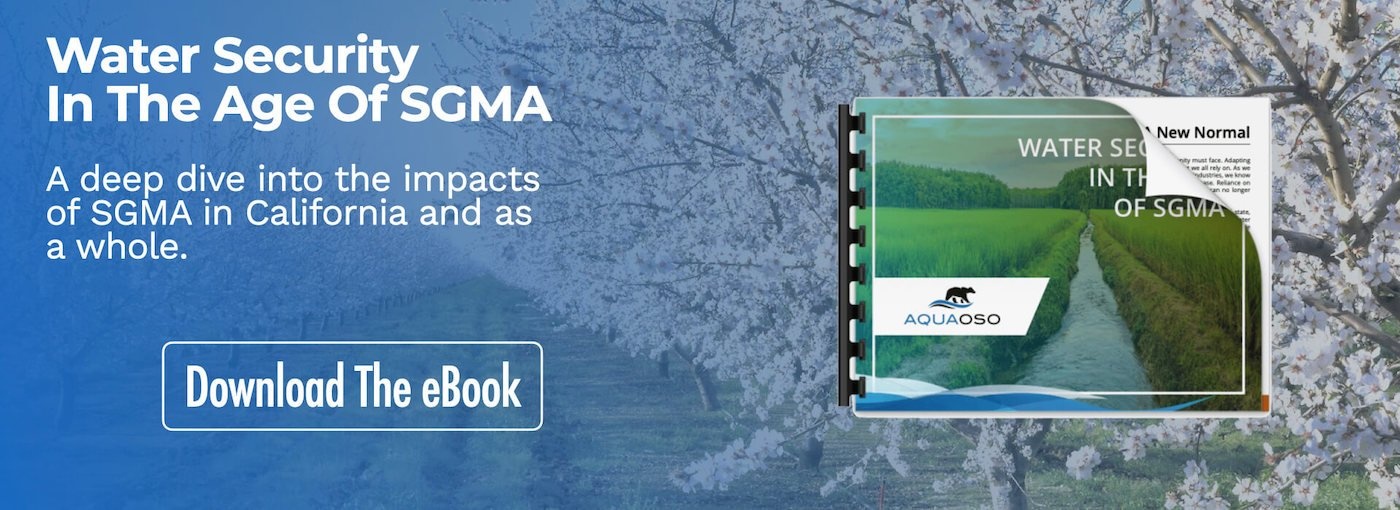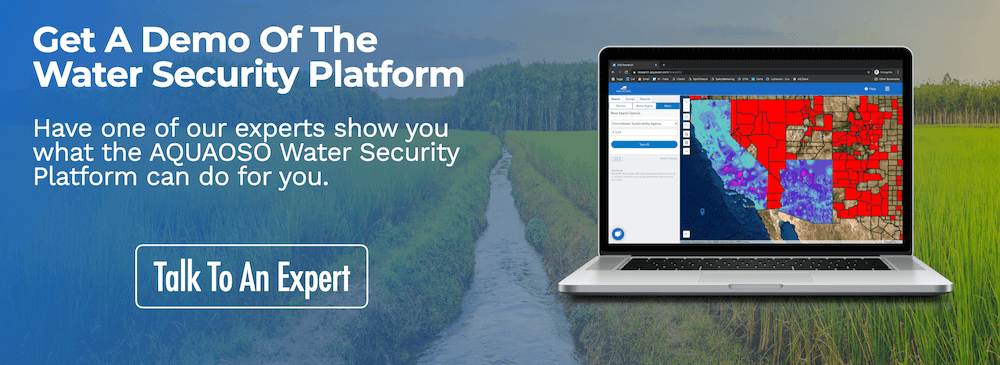How Sustainable Agriculture Investment Is Linked To Better ROI
With increased water scarcity on the horizon and global food security at risk, investing in sustainable agriculture isn’t just a moral imperative – it’s also a smart business move. In recent years, more and more investors have given more attention to ESG (Environmental, Social, and Governance) funds and other types of sustainable investments.
A recent report in the New York Times suggests that “64 percent of actively managed E.S.G. funds beat their benchmarks versus 49 percent of traditional funds through the first week in August.” While this report is promising, it does caution that some of this shift may be due to reduced demand for oil during the coronavirus crisis:
“Excluding oil companies remains a straightforward choice. Investing in ways that promote an idea or a thesis — like equity — is more complex.”
Because agriculture accounts for as much as 90% of water use in the Western U.S., it’s important to consider drought risk, water scarcity, and water costs when pursuing land deals and other agricultural investments. As the Source Magazine explains,
“Water-related investments require water resources management knowledge to be successful.”
Investors who understand these issues can price water risk directly into their portfolios, resulting in a better ROI and long-term agriculture investment success. But finding access to the information needed to understand water risk in agriculture isn’t always easy.
This article takes a look at what sustainable agriculture investing means in the context of water resiliency, and how better data will play a key role in increasing ROI and facilitating smarter, more profitable investments.
(Part of our Agriculture Investing Guide)
How sustainable agriculture investing and water intersect
According to Trillium Asset Management, investing in sustainable agriculture can mean anything from “real estate investments in sustainably managed farmland and forests to debt investments in farms, cooperatives, and food enterprises, to equity investments… in healthy food companies, retailers, and agricultural technologies.”
These investments can encourage more efficient use of water, energy, and other natural resources used in farming, as well as better land management. When it comes to water, investors can choose to invest in farms that incorporate sustainable water management, and they can use information on historical water use, drought risk, regional regulations, and water rights to inform their investments.
Taking a long-term view
The key is to make investments that encourage long-term management of resources. As Frontiers in Environmental Science puts it: “Current water and energy charges are often too low to affect behaviour. The irony is that by providing water and energy for agriculture at a low cost, food security can itself ultimately be threatened.”
Agricultural investors should spend time learning about current water cost trends and familiarize themselves with smart water markets and other ways of buying and selling water. While the up-front learning curve can be steep, tools like AQUAOSO’s Water Security Platform are making it easier to access the information needed to make smart agricultural investments.
Aside from directly investing in farmland, agricultural investors can look for opportunities in wastewater treatment, climate-controlled agriculture, water infrastructure, and more. A massive funding gap means there are no shortages of projects to invest in.
Why sustainable agriculture investment is more profitable than traditional agriculture investing
While groups like the Environmental Defense Fund have long called for better financing of resilient agriculture, sustainable investing isn’t limited to a small group of eco-friendly investors. It includes well-known firms like BlackRock, J.P. Morgan, and BNP Paribas – which is the 8th largest bank the world and has a footprint in 72 countries.
“We believe that the viability of the current economic model is coming to an end,” they write in a recent blog post. “Reliable research by Oxford University and others confirms that good sustainability and ESG practices correlate with lower operating costs, better profitability, and superior share price performance.”
Multiple factors drive this performance. Below are a few key inputs that help explain the increased ROI of sustainable agriculture investment.
Longevity
According to the EDF, sustainable farming practices contribute to long-term viability by “stabilizing crop yields, lowering costs of production, diversifying revenue streams and preserving the long-term value of the land.” Not only that, but “this value is particularly evident when viewing farm budgets over multiple years.”
That’s why one company that invests in sustainable farming, Nuveem, is in it for the long-haul: “With investments that often last 20 years or more,” they explain, “we are committed to preserving farmland for the long term – conserving water, minimizing chemical use and nutrient runoff and respecting the rights of our tenants.”
This kind of perspective is a must for investors looking for a stable ROI, and can help lock in the long-term benefits of sustainable agriculture investment.
Risk resilience
Agriculture is an inherently volatile industry, susceptible to drought, extreme weather events, and the slow but steady impact of climate change, especially in the American West.
The EDF suggests that increasing risks “will challenge lenders to change their thinking and give increased weight to how their customers farm, mitigate climate risk, and position themselves to be resilient and sustainable for the long term.”
One approach is to factor climate and water risk directly into loans and investments. As MarketWatch puts it, “Banking regulators currently require banks to conduct tests to see how they’d fare in a variety of threatening scenarios, such as cyberattacks, pandemics, currency manipulation, and trade wars. They can do the same for climate change.”
Agricultural investors can use tools like AQUAOSO to view a parcel’s Water Security Score and get an accurate assessment of an investment’s water risk.
Higher profit margins
Investors may worry that the short-term costs of implementing sustainable practices will offset any long-term gains. But some research suggests that sustainable agriculture has higher profit margins than conventional agriculture, in part due to the higher premiums that farmers can charge for organic and sustainably-grown produce as well as higher yield potential with practices like regenerative and/or no-till agriculture.
Additionally, farmers can diversify their income streams by planting multiple crops, or by mixing livestock and row crops, instead of relying on monocropping. Not only does this improve ROI and risk resilience, it can also save money and reduce the environmental impact by swapping out toxic fertilizers with natural alternatives.
This type of circular agriculture can result in lower costs and a lower carbon footprint, due to reduced inputs needing to be purchased and transported. The EDF also reports that “crop rotations … have been found to lower farm input costs due to decreased pest pressure and reduced soil-borne diseases” and that “more diverse rotations increased corn yields over time and across all growing conditions.”
Healthier land and soils
Finally, sustainable agriculture investments can result in long-term improvements to the land and reduce the risks associated with conventional farming practices. This includes negative impacts on the people who live or work on the land due to toxic pesticides or fertilizers, as well as impacts on local wildlife and water resources.
For example, some conventional farming methods have been shown to increase algal blooms, harm bee populations, and reduce fish populations in local watersheds. While chemical inputs and other methods can increase short-term yields, sustainable farming practices increase long-term profitability and increased water and soil resiliency.
How AQUAOSO Can Help
Sustainable agriculture investment isn’t just more ethical – it can be more financially secure. The same factors that make a parcel of land more productive and resilient can also increase investors’ ROI.
By investing in farms that are water-secure and take a sustainable approach to land management, investors can be better protected against climate risks and less likely to lose money on unprofitable investments. As CEO Chris Peacock explains:
“We believe in the economics of land stewardship; if you do things the right way, you can get higher value out of your investments over time.”
Making smart investment decisions involves in-depth research, and without access to the right resources and datasets, it can be very difficult to obtain all of the information needed to determine water risk in an investment.
AQUAOSO is committed to addressing this problem. By combining data from multiple resources, AQUAOSO provides practical, on-demand access to water insights that are sharable with other stakeholders while researching a potential investment opportunity.
The Water Security Platform provides comprehensive information on water security and risk from both a regional perspective and on a parcel-by-parcel basis.
Ultimately, AQUAOSO help investors:
- Acquire more land
- Improve risk decisions
- Monitor portfolios
- Enhance relationships
… all by expanding and deepening the understanding of water.
Read more about water risk in agriculture investment in our explorable guide.
The Bottom Line
AQUAOSO is committed to providing actionable resources that our customers can use to make better investment decisions. And because our tools are cloud-based and customizable, they can flexible to meet the needs of your organization.
Reach out to us today to learn more or request a demo, or browse our resources page to keep up on the latest trends in water security.
Recent Posts
Agcor and AgWare Celebrate 2 Years of Groundbreaking Integration, Setting the Standard in Agricultural Appraisal Efficiency
PRESS RELEASE For Immediate Release DENVER, March 21, 2024 -- Agcor, an AQUAOSO Technologies, PBC brand, a leading provider of agricultural lending software solutions, announces a significant milestone in its partnership with AgWare, a premier developer of innovative...
AQUAOSO launches Agcor – a full suite of digital tools for the modern ag lender.
PRESS RELEASE For Immediate Release Denver, CO - Today, AQUAOSO Technologies, PBC officially unveiled Agcor™ - a suite of software tools for the modern ag lender. The software is purpose-built by and for agricultural lenders to unlock the power of...
AQUAOSO’s Climate Intelligence Platform Showcased At OnRamp Conference
PRESS RELEASE For Immediate Release AQUAOSO showcases GIS Connect, a climate intelligence platform that helps US financial institutions mitigate climate risk during the recent OnRamp Agriculture conference. AQUAOSO shares their story of substantial growth as...



